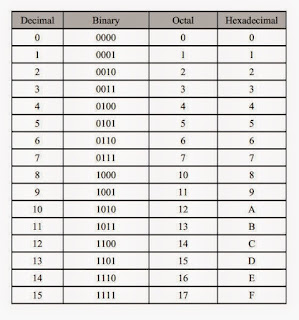If
you are new to this article, I strongly recommend to read our previous article
before preceding this. In our previous article, we had already seen that binary
number has a base of 2. It means that binary number contains 21 = 2
combinations which are 0 and 1. Similarly, Octal and Hexadecimal number has a
fixed number of combinations. As we earlier know that octal has a base 8, then
it contains 8 digits through 0 to 7 which means 23 =8 combinations
and Hexadecimal has a base 16 which means it has 24=16 combinations.
If you are focusing on a
sequence i.e. octal, hexadecimal. They are the combinations of increasing power
of 2.
Octal
– 23 , Hexadecimal - 24
This
power indicates how many bits are in a number for a particular number system
Octal
has 3 bits
Hexadecimal
has 4 bits
This
can be clear understand by following diagram-
Explain
– In this diagram, first we consider decimal number up to 7
You
can clearly seen in this diagram that binary numbers has 0 at its first
position, so you can write or remove this 0. Now if you remove this 0 than it
has remaining only 3 binary bits which are [ 000, 001, 010, 011, 100,
101,110,111 ] these are the binary representation of octal Numbers [ 0, 1, 2,
3, 4, 5, 6, 7]
Now
consider after 7 Number, binary number contains 1 at its first
position, so we cannot remove this at its position, if we do not remove 1 at
its position it contains 4 binary bits which are [ 0000, 0001, 0010, 0011,
0100, 0101, 0110, 0111, 1000, 1001, 1010, 1011, 1100, 1101, 1110, 1111] and
these are the binary representation of Hexadecimal Number [ 0, 1, 2, 3, 4, 5,
6, 7, 8, 9, A, B, C, D, E, F]
Now
we are ready to convert binary to octal, octal to binary, binary to
hexadecimal, hexadecimal to binary. The following example illustrates the procedure :
( 10 110 001 101 011 . 111 100 000 110)2 = (26153.7406)8
2 6 1 5 3 . 7 4 0 6
Conversion from binary to hexadecimal is similar, except that the binary number is divided into groups of four digits :
(10 1100 0110 1011 . 1111 0010)2 = (2C6B.F2)16
2 C 6 B . F 2
Conversion from octal or hexadecimal to binary is done by a procedure reverse to the above.Each octal digit is converted to its 3-digit binary equivalent. Similarly, each hexadecimal digit is converted to its 4-digit binary equivalent. This is illustrated in the following examples:
(673.124)8 = (110 111 011 . 001 010 100)2
(306.D)16 = (0011 0000 0110 . 1101)2
« Previous Complement of a Number »

Comments
Post a Comment